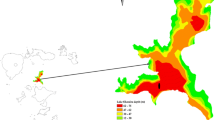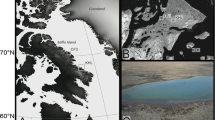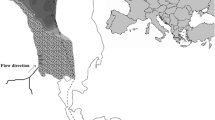Abstract
The primary producer community of Lake Apopka, a large (125 km2), shallow (mean depth, 1.7 m), polymictic Florida lake, shifted from macrophyte dominance to phytoplankton dominance in the 1940s. Today, frequent wind resuspension of highly organic, unconsolidated sediments supports a meroplanktonic community that is predominantly diatoms, but during calm periods the algal community is dominated by planktonic cyanobacteria. Sedimentary algal pigments (chlorophyll derivatives and carotenoids) and chemical proxies for nutrient enrichment (polyphosphate, total phosphorus and biogenic silica) in three sediment cores were used to investigate historic changes in primary producers. Sediments were separated into three stratigraphic zones using multivariate statistical techniques. Stratigraphic zonation was established in each core although sediment deposition at one site was insufficient to adequately resolve temporal changes. These results show the importance of selecting suitable sites for paleolimnological studies. The oldest zone represents macrophyte-derived sediments, and the two overlying zones represent phytoplankton-derived sediments deposited since the 1940s. Algal pigments in the most recent sediment zone show little degradation, which might be due to the presence of viable meroplankton in the sediment. After the initial primary producer shift from macrophytes to phytoplankton, the lake experienced a short period of cyanobacterial dominance followed by a period of benthic diatom abundance before being replaced by the present algal community consisting of cyanobacteria and meroplanktonic diatoms. Chlorophyll derivatives and carotenoids were highly correlated with total phosphorus. Historic trends inferred from the data include algal and cyanobacterial productivity that increased with increased phosphorus loading. The study demonstrates that valid paleolimnological proxies for historic eutrophication are available in loosely consolidated sediments of shallow, subtropical lakes.
Similar content being viewed by others
References
F.J. Aldridge C.L. Schelske H.J. Carrick (1993) ArticleTitleNutrient limitation in a hypereutrophic Florida lake Arch. Hydrobiol. 127 21–37
InstitutionalAuthorNameAPHA (1989) Standard Methods for the Examination of Water and Wastewater17th ed American Public Health Association Washington, DC 1081
R.W. Bachmann M.V. Hoyer D.E. Canfield SuffixJr. (1999) ArticleTitleThe restoration of Lake Apopka in relation to alternative stable states Hydrobiologia 394 219–232
R.W. Bachmann M.V. Hoyer D.E. Canfield SuffixJr. (2000) ArticleTitleInternal heterotrophy following the switch from macrophytes to algae in Lake ApopkaFlorida Hydrobiologia 418 217–227
R.W. Bachmann M.V. Hoyer D.E. Canfield SuffixJr. (2001) ArticleTitleEvaluation of recent limnological changes at Lake Apopka Hydrobiologia 448 19–26
L.E. Battoe M.F. Coveney E.F. Lowe D.L. Stites (1999) The role of phosphorus reduction and export in the restoration of Lake ApopkaFlorida K.R. Reddy G.A. O’Connor C.L. Schelske (Eds) Phosphorus Biogeochemistry in Subtropical Ecosystems Lewis Publishers Boca Raton 511–526
Brezonik P.L., Pollman C.D., Crisman T.L., Allinson J.N. and Fox J.L. 1977. Limnological studies on Lake Apopka and the Oklawaha chan of lakes 1. Water quality in 1977. Report to Florida Department of Environmental Regulation, Tallahassee. Report No. ENV-07-78-01, Department of Environmental Engineering Sciences, University of Florida109 pp.
D.E. Canfield K.A. Langeland M.J. Maceina W.T. Haller J.V. Shireman J.R. Jones (1983) ArticleTitleTrophic state classification of lakes with aquatic macrophytes Can. J. Fish. Aquat. Sci 40 IssueID10 1713–1718
H.J. Carrick F.J. Aldridge C.L. Schelske (1993) ArticleTitleWind influences phytoplankton biomass and composition in a shallow, productive lake Limnol. Oceanogr. 38 1179–1192
H.L. Carrick C.L. Schelske (1997) ArticleTitleHave we overlooked the importance of small phytoplankton in productive waters? Limnol. Oceanogr. 42 1613–1621
D.J. Conley C.L. Schelske (1993) ArticleTitlePotential role of sponge spicules in influencing the silicon biogeochemistry of Florida lakes Can. J. Fish. Aquat. Sci. 50 296–302
M. Dickman X. Han (1995) ArticleTitlePaleopigment evidence of competition between phytoplankton and a cyanobacterial algal mat in a meromictic lake near TorontoOntario Canada Hydrobiologia 306 131–146
D.R. Engstrom E.B. Swain J.C. Kingston (1985) ArticleTitleA paleolimnological record of human disturbance from Harvey’s LakeVermont: geochemistry, pigments and diatoms Freshwater Biol. 15 261–288
M. Feuillade J. Dominik J. Druart J. Loizeau (1995) ArticleTitleTrophic status evolution of Lake Nantua as revealed by biological records in sediment Arch. Hydrobiol. 132 337–362
M.M. Fisher M. Brenner K.R. Reddy (1992) ArticleTitleA simpleinexpensivepiston corer for collecting undisturbed sediment/water interface profiles J. Paleolimnol. 7 157–161
G. Fitzgerald T.C Nelson (1966) ArticleTitleExtractive and enzymatic analysis for limiting or surplus phosphorus in algae J. Phycol. 2 32–37
M. Griffiths W.T. Edmondson (1975) ArticleTitleBurial of oscillaxanthin in the sediment of Lake Washington Limnol. Oceanogr. 20 945–952
L. Hakanson M. Jansson (1983) Principles of Lake Sedimentology Springer-Verlag New York 316
JMP 1995. Version 3. SAS Institute Inc., Cary, NC, 593 pp.
W.F. Kenney C.L. Schelske A.D. Chapman (2001) ArticleTitleChanges in polyphosphate sedimentation: a response to excessive phosphorus enrichment in a hypereutrophic lake Can. J. Fish. Aquat. Sci. 58 879–887
W.F. Kenney M.N. Waters C.L. Schelske M. Brenner (2002) ArticleTitleSediment records of phosphorus-driven shifts to phytoplankton dominance in shallow Florida lakes J. Paleolimnol. 27 367–377
A. Lami F. Niessen P. Guilizzoni J. Masaferro C.A. Belis (1994) ArticleTitlePalaeolimnological studies of the eutrophication of volcanic Lake Albano (Central Italy) J. Paleolimnol. 10 181–197
P.R. Leavitt (1993) ArticleTitleA review of factors that regulate carotenoid and chlorophyll deposition and fossil pigment abundance J. Paleolimnol. 9 109–127
P.R. Leavitt D.L. Findlay (1994) ArticleTitleComparison of fossil pigments with 20 years of phytoplankton data from eutrophic lake 227, Experimental Lakes AreaOntario Can. J. Fish. Aquat. Sci. 51 2286–2299
P.R. Leavitt D.A. Hodgson (2001) Sedimentary pigments J.P. Smol H.J.B. Birks W.M. Last (Eds) Tracking Environmental Changes in Lake Sediments: Volume 3: Terrestrial, Algal, and Siliceous Indicators Kluwer Academic Publishers Dordrecht 281–293
E.F. Lowe L.E. Battoe M.F. Coveney D.L. Stites (1999) ArticleTitleSetting water quality goals for restoration of Lake Apopka: inferring past conditions Lake Reserv. Manage. 15 103–120
E.F. Lowe L.E. Battoe M.F. Coveney C.L. Schelske K.E. Havens E.R. Marzolf K.R. Reddy (2001) ArticleTitleThe restoration of Lake Apopka in relation to alternative stable states: an alternative view to that of Bachmann et al. (1999) Hydrobiologia 448 11–18
J.W.G. Lund (1954) ArticleTitleThe seasonal cycle of the plankton diatomMelosira italica Kutz. subarctica O Mull. J. Ecol. 42 151–179
S. Newman F.J. Aldridge E.J. Phlips K.R. Reddy (1994) ArticleTitleAssessment of phosphorus availability for natural phytoplankton populations from a hypertrophic lake Arch. Hydrobiol. 130 409–427
C.S. Reynolds (1980) ArticleTitlePhytoplankton assemblages and their periodicity in stratifying lake systems Hol. Ecol. 3 141–159
Reynolds C.S. 1984. The Ecology of Freshwater Phytoplankton. Cambridge384 pp.
M. Rybak (1988) ArticleTitleThe effect of agriculture on the primary production in Lake Beskie (Poland) as recorded in the stratigraphy of fossil pigments Hydrobiologia 157 21–26
S. Sabater E.Y. Haworth (1995) ArticleTitleAn assessment of recent trophic changes in Windermere South Basin (England) based on diatom remains and fossil pigments J. Paleolimnol. 14 151–163
M. Sakamoto T. Inoue (1996) ArticleTitleTyphoon-induced temporal change in plankton phosphorus in Lake Biwa Jpn. J. Limnol. 57 511–522
M. Scheffer S.H. Hosper M.-L. Meijer B. Moss E. Jeppesen (1993) ArticleTitleAlternative equilibria in shallow lakes Trends Ecol. Evol. 8 275–279
C.L. Schelske (1997) Sediment and Phosphorus Deposition in Lake Apopka: Final Report. Special Publication SJ97-SP21 St. Johns River Water Management District PalatkaFlorida
C.L. Schelske P. Brezonik (1992) Can Lake Apopka be Restored? Restoration Case Studies National Academy Press Washington, DC 393–398
C.L. Schelske W.F. Kenney (2001) ArticleTitleModel erroneously predicts failure for restoration of Lake Apopkaa hypereutrophic, subtropical lake Hydrobiologia 448 1–5
C.L. Schelske F.J. Aldridge H.J. Carrick M.F. Coveney (2003) ArticleTitlePhytoplankton community photosynthesis and primary production in a hypereutrophic lakeLake ApopkaFlorida Archiv. Hydrobiol. 157 145–172
C.L. Schelske H.J. Carrick F.J. Aldridge (1995) ArticleTitleCan wind-induced resuspension of meroplankton affect phytoplankton dynamics? J. N. Am. Benthol. Soc. 14 616–630
C.L. Schelske D.J. Conley E.F. Stoermer T.L. Newberry C.D. Campbell (1986) ArticleTitleBiogenic silica and phosphorus accumulation in sediments as indices of eutrophication in the Laurentian Great Lakes Hydrobiologia 143 79–86
C.L. Schelske M.F. Coveney F.J. Aldridge W.F. Kenney J.E. Cable (2000) ArticleTitleWind or nutrients: historic development of hypereutrophy in Lake ApopkaFlorida Arch. Hydrobiol. Spec. Issues Adv. Limnol. 55 543–563
C.L. Schelske C.M. Donar E.F. Stoermer (1999) A test of paleolimnologic proxies for the planktonic/benthic ratio of microfossil diatoms in Lake Apopka Mayama Idei Koizumi (Eds) 14th International Diatom SymposiumSeptember 2–8, 1996, TokyoJapan Koeltz Scientific Books Koenigstein 367–382
Schelske C.L., Lowe E.F., Battoe L.E., Brenner M., Coveney M.F. and Kenney W.F. Abrupt biological response to hydrologic and land-use changes in Lake ApopkaFlorida (USA). Ambio. (accepted).
B.C. Shumate C.L. Schelske T.L. Crisman W.F. Kenney (2002) ArticleTitleResponse of the cladoceran community to trophic state change in Lake ApopkaFlorida J. Paleolimnol. 27 71–77
L. Sicko-Goad E.F. Stoermer J.P. Kociolek (1989) ArticleTitleDiatom resting cell rejuvenation and formation: time-coursespecies records and distribution J. Plankton Res. 11 375–389
C.L.M. Steenbergen H.J. Korthals E.G. Dobrynin (1994) ArticleTitleAlgal and bacterial pigments in non-laminated lacustrine sediment: Studies of their sedimentation, degradation and stratigraphy FEMS Microbiol. Ecol. 13 335–352
E.B. Swain (1985) ArticleTitleMeasurement and interpretation of sedimentary pigments Freshwater Biol. 15 53–75
Tuschall J.R., Crisman T.L., Brezonik P.L. and Allinson J.N. 1979. Limnological studies on Lake Apopka and the Oklawaha chain of Lakes 2. Water Quality in 1978. Report to Florida Department of Environmental Regulation, Tallahassee. Report No. ENV-07-79-02, Department of Environmental Engineering Sciences, University of Florida. 114 pp.
R.G. Wetzel (1970) ArticleTitleRecent and postglacial production rates of a marl lake Limnol. Oceanogr. 15 491–503
T.J. Whitmore M. Brenner C.L. Schelske (1996) ArticleTitleHighly variable sediment distribution in shallow, wind-stressed lakes: a case for sediment-mapping surveys in paleolimnological studies J. Paleolimnol. 15 207–221
Author information
Authors and Affiliations
Corresponding author
Rights and permissions
About this article
Cite this article
Waters, M.N., Schelske, C.L., Kenney, W.F. et al. The use of sedimentary algal pigments to infer historic algal communities in Lake Apopka, Florida. J Paleolimnol 33, 53–71 (2005). https://doi.org/10.1007/s10933-004-1691-7
Received:
Accepted:
Issue Date:
DOI: https://doi.org/10.1007/s10933-004-1691-7




